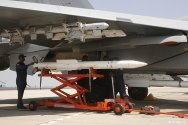While I am not saying the model shown is necessarily inaccurate, I will personally wait for further images, of the real missile or real J-20, to be able to make a decision on the likelihood of that particular missile design and load configuration.
That's not to say 3 missiles in a bay is unlikely in the future, it will most probably happen at some point, and there already are unsubstantiated rumors about it, but certain elements in that model just don't scream as credible until corroborated by images of the actual thing.
Firstly, i have yet to see a high speed AAM missile that's been fielded anywhere in the world, with folding fins. While it may seem like a logical thing to do, obviously there are drawbacks to that solution, otherwise everyone who has stealth jets would also use such missiles. (weight and added drag are among them) That doesn't mean such missiles can't happen in the future, and it doesn't mean China won't be the first country to field such a missile - but I personally won't use an image of a tabletop model plane to make my decision on it. (R-77 does not have folding fins, as the control lattices are just that - lattices. Not fins. No one else uses that solution on an AAM and even the russian newest missile has reverted to fins, rather than lattices)
Secondly, not to use a staggered arrangement of missiles when 3 missiles are in a bay is wasteful and probably unlikely. There are two options, really. One, to have long missiles which take up most of the length of the bay, which would preclude staggering the position of the middle one. But for that to work and still have room for 3 missiles, the missiles themselves would have to be quite narrow.
Second option would be to have a shorter missile, not by much, and certainly still longer than an amraam, so the staggered arrangement can be accommodated. That would also mean missiles themselves could be made wider, which is pretty important for various front section subsystems. Bigger cross section usually means more capable seeker, fuze, warhead, etc. Staggered arrangement would make any folding fins and the drawbacks coming with those unnecessary.
Bigger cross section also means more drag, but that ties into a discussion of what the new smaller missiles would be all about. If it is to completely replace PL-15, then suffering more drag and thus having shorter range might not be acceptable. But personally, I find it more likely that the new missile would serve alongside the PL-15. That it's really a custom made solution for the stealth planes, to be able to carry more missiles in missions against other stealth jets. So in missions requiring chase of tankers for example, four PL-15 might still rather be used, instead of 6 new missiles.
Technology wise, the new missile will likely share its electronics with the next variant of PL-15 then. So it's not like future PL-15 would be behind in that department.


